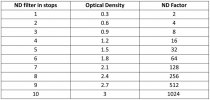The big problem with polarizers on drones is that you can't adjust them during flight. You have to compose the photo and position the drone to suit the polarizer rather than adjust the polarizer to suit the photo.
It's long been encouraged in photography to pre-visualize your shots.
Given that you have an idea of the angle you'll want the left hand rule works pretty good for presetting the filter.
That said I do not use them typically on sunny days with lots of blue sky for the uneven gradient.
I DO use them on cloudy days because it gives you great saturation.
As far as ND goes it's all up to what you want to use it for. You can calculate what ND you need if you have an ambient light meter that can read in Ev (exposure value).
The following assumes you're following the 180 degree rule where the shutter speed is 2x the frame rate.
My
Mini 3 Pro has a lens aperture of f1.8. I usually shoot at 24fps so shutter speed is 1/50.
That gives me an Ev value of 7.3 @ ISO 100. That means if you read an ambient light level of Ev 7.3 it will be a perfect exposure as-is.
So now if I read the ambient light is 16Ev then I have a difference of roughly 9 - which translates into 9 stops too much light. So to knock it down as close as possible to my "native" Ev, I would pick an ND filter that gets me as close as possible. Referring to the chart I've attached you can see an ND512 would get me there.
So an ND1000 filter would be an additional stop so you'd only be able to get shutter speed down to 1/25 of a second.
Most drones like teh
Air 2S have a f2.8 lens which has a "native" Ev at 1/50th of 8.67. So an
Air2S for a bright sunny day with Ev 16 would be roughly 7 stops so you'd need an ND128 filter. It will be approximately 1/3 stop over but that's the nature of the beast since most don't have variable apertures.
You could in fact raise teh shutter speed to 1/60 which would be close to that 1/3 stop and still within the parameters for "cinematic" video footage.
Note that you can use different ISOs as part of the equation if you need to.
I picked Ev 16 because it handily falls in with the "Sunny 16" rule for estimating exposure.
Sunny 16 says that on a
typical bright sunny day if you set your aperture to f16 and your shutter speed to a reciprocal of your ISO then you will get a good exposure. So ISO 200 you'd set your shutter speed as close to 1/200 as you could.
Probably this has been TMI to the "keep trying 'til you get it right" crowd but it never hurts to share a bit of knowledge.
FWIW I use the Sekonics L-758DR light meter because it allows me to profile up to 4 cameras and it can take multiple reading and show me the dynamic range of a scene allowing me to shift the proper exposure to capture it all given the camera's limitations. Worst case it will show me what exposure will give me the most of the scene's details.













